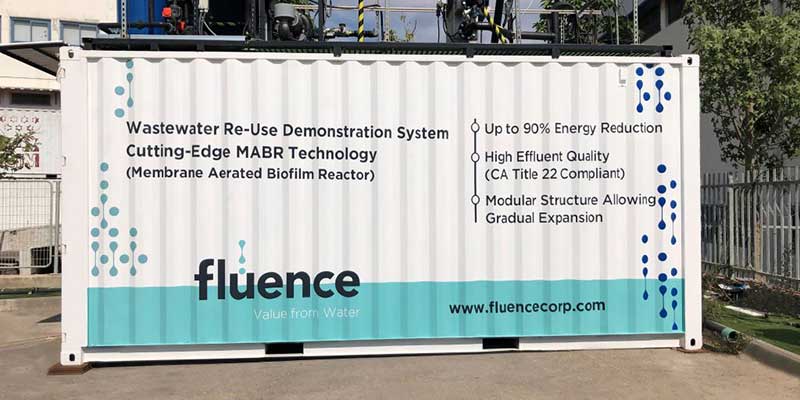
The containerized MABR plant is located at the William and Cloy Codiga Resource Recovery Center in Palo Alto.
Fluence’s first MABR plant in mainland U.S. gives California new medium- and small-scale treatment options that comply with the state’s stringent standards for water reuse
Water recycling, which sometimes is referred to by the unfortunate description “toilet-to-tap,” is becoming more and more important in a world facing increasing water scarcity. But the United States has been lagging much of the world in adopting this important water management strategy, particularly due to public sentiment.
The reuse of wastewater is especially important in California, which may soon see a return to drought conditions after a short reprieve.
Reclaim, Recycle, Reuse
Title 22 is a section of the California Code of Regulations (CCR) that enumerates the state’s stringent environmental health regulations. As the Water Education Foundation explains, California’s standards for reclaimed water discharge and reuse are regulated by Title 22’s Chapter 3, Water Recycling Criteria, and the 1969 Porter-Cologne Water Quality Control Act.
Title 22 is important to California’s long-term water goals, which are:
- Increasing recycled water use over 2002 levels by a million acre-feet annually by 2020, and by at least 2 million acre-feet a year by 2030
- Increasing stormwater use over 2007 levels by at least half a million acre-feet annually by 2020, and by a million acre-feet annually by 2030
In California, groundwater aquifers are facing the consequences of industrial pollution and depletion from drought and overuse. As Emily Benson of The Mercury News explained, where water is continually withdrawn and the water table drops, subsidence can be a problem. In coastal areas, overuse of groundwater can cause saltwater intrusion into aquifers, contaminating the water and making it unusable for many vital needs.
Energy-Saving MABR
In keeping with California’s stringent standards for indirect potable reuse for aquifer recharge, Fluence announced at the end of January 2018 that it had commissioned the first-ever membrane aerated biofilm reactor (MABR) containerized wastewater treatment demonstration unit on the U.S. mainland. Fluence Managing Director and CEO Henry Charrabé explained:
Fluence’s innovative MABR technology as a reuse solution solves the water scarcity problem efficiently and cost-effectively […] in California.
MABR is a revolutionary aerobic wastewater treatment process that slashes the energy used for aeration by 90%. Fluence’s other MABR plant in the U.S., on St. Thomas in the U.S. Virgin Islands, was operational throughout 2017, weathering Hurricane Irma’s strike on the island unscathed.
MABR Demonstration Plant
The new, fully operational demonstration unit in Palo Alto will be tested and evaluated for a year to demonstrate its compliance with California’s stringent standards for water reuse.
The unit is proving itself in preparation for expected heavy use as California prepares for a drought-prone future. Although the Fluence MABR is being tested for indirect potable reuse, it does notproduce drinking water on its own. Criteria in Title 22 specify standards for indirect potable reuse for subsurface application.
Natural Water Purification
For decades, California has used aquifers as massive water storage structures, like dams, but without the enormous construction costs to pass on to the taxpayer. The state typically has diverted natural water sources to recharge groundwater. After the required year of observation and testing, Fluence MABR units will be qualified to treat wastewater to reuse quality and provide a source for irrigation and aquifer recharging.
Once water enters the aquifer, nature continues a process of purification. According to the Safe Drinking Water Foundation:
Almost no bacteria live in aquifers. Many pollutants are filtered out as the water passes through the soil on its way to the aquifer.”
Decentralized Treatment
Not only is the Palo Alto demonstration unit significant as Fluence’s first MABR unit in the mainland U.S., but it also gives California new medium- and small-scale treatment options in a state known for going large with wastewater treatment and desalination infrastructure.
MABR’s high energy efficiency means it can be used with solar power in remote areas and off the electrical grid, bringing treatment to wherever water is needed and to sources of pollution.
